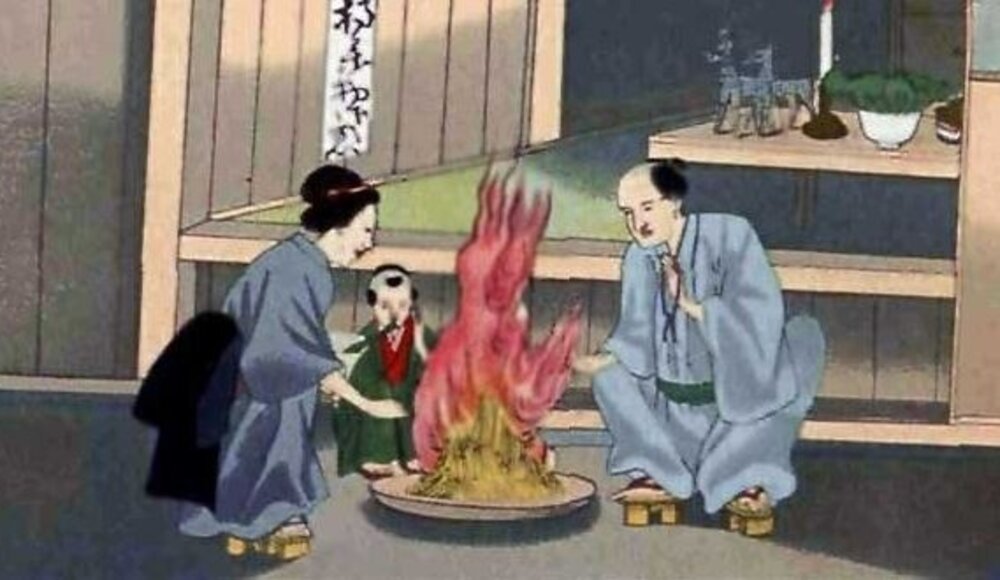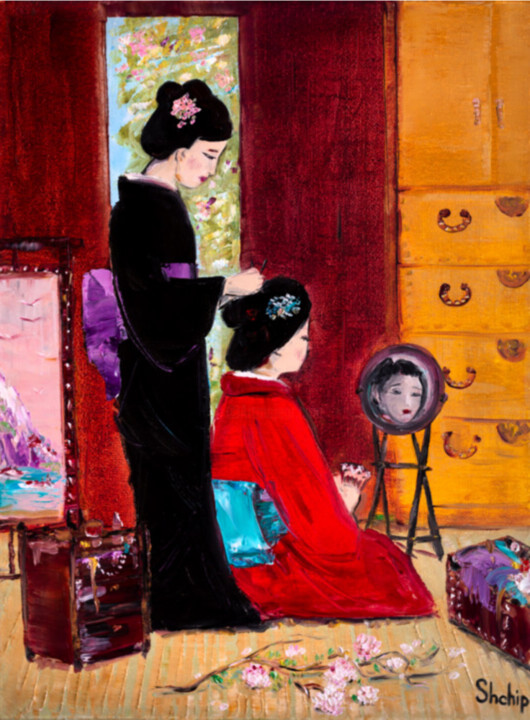Historical Background
Obon, also known simply as Bon, is a deeply rooted Japanese tradition intertwining ancient beliefs with Buddhist customs. Originating over 500 years ago, Obon represents a harmonious blend of reverence for ancestral spirits and Buddhist practices, evolving into a significant family reunion holiday in Japan.
The festival's roots lie in Buddhist lore, particularly the story of Maha Maudgalyayana, a disciple of Buddha, who sought to alleviate his mother's suffering in the Realm of Hungry Ghosts. Upon Buddha's guidance, Maudgalyayana made offerings to monks on the fifteenth day of the seventh month, leading to his mother's liberation and his own joyous dance. This dance, known as Bon Odori or "Bon Dance," symbolizes remembrance and gratitude towards ancestors and their sacrifices.
Obon spans three days, its commencement varying across regions due to historical calendar transitions. Shichigatsu Bon (July Bon) aligns with the solar calendar, celebrated around July 15th in eastern Japan, while Hachigatsu Bon (August Bon) follows the lunar calendar, occurring around August 15th and being the most widespread celebration. Kyū Bon (Old Bon), observed in regions like the northern Kantō, Chūgoku, Shikoku, and Okinawa, falls on the 15th day of the seventh lunar month, fluctuating yearly between August 8th and September 7th.
While not designated as public holidays, it is customary for people to be granted leave during these festival days. Traditionally, Obon is a time for familial gatherings, visiting ancestral graves, and performing rituals like Okuribi, symbolizing the return of ancestral spirits with the aid of fire.
Obon's vibrant atmosphere extends to its rituals and festivities. Participants don yukata, lightweight cotton kimonos, and engage in carnival-like celebrations featuring rides, games, and summer delicacies. A significant ritual involves crafting cucumber horses and eggplant cows, serving as vessels for ancestral spirits to return and depart, respectively.
The etymology of Obon traces back to the honorific prefix "o-" combined with "bon," derived from Chinese terms Yúlánpén or Yúlánpénhuì, possibly originating from the Pali term ullumpana, signifying "raising up; saving; helping."
Obon continues to be a cherished tradition, embodying Japan's cultural heritage and spiritual reverence for ancestors, while also evolving with contemporary customs and interpretations.

Photo from "Sketches of Japanese Manners and Customs", by J. M. W. Silver, Illustrated by Native Drawings, Reproduced in Fac-simile by Means of Chromo-lithography, published in London in 1867, via Wikipedia
Themes and Symbols
In Japan, during the Obon period around the 15th of the 7th month of the old lunar calendar, events are held to honor deceased relatives. While some regions celebrate Obon from July 13th to 16th, others observe it from August 13th to 16th. "Bon-Odori," a traditional dance performed during Obon, serves as a means to welcome and bid farewell to ancestral spirits. Today, the religious significance has waned, and the dance primarily enlivens summer festivals. The choreography often mirrors actions like "harvesting rice" or "scooping mud," making it accessible to all, typically performed in yukata attire, adding to the festive atmosphere that transcends generations.
Symbolism through Movement: The choreography of Bon dances often mirrors the historical context and specialized industries of the region and are performed to the tune of Obon folk songs. For instance, the "Tankō Bushi" of Kyushu mimics coal miners' movements, while the "Soran Bushi" echoes the actions of fishermen. Each region in Japan boasts its unique Bon dance and accompanying music, reflecting local traditions and heritage. From the spirited "Sōran Bushi" of Hokkaidō to the lively "Awa Odori" of Tokushima, these dances encapsulate the essence of their respective locales.
Inclusivity and Unity: Despite regional variations, all dancers perform the same sequences in unison, fostering a sense of communal spirit and solidarity. The circular formations around a central yagura, or wooden scaffold, symbolize the cyclical nature of life and the interconnectedness of past and present. Beyond traditional tunes, Bon Odori embraces modernity, incorporating enka hits and children's tunes into its repertoire. This amalgamation of old and new reflects the evolving cultural landscape of Japan. In countries like the Philippines and Argentina, Obon festivals serve as platforms for Japanese diaspora communities to celebrate their heritage while fostering intercultural understanding and friendship.
Community Engagement: In North America, Japanese-American and Japanese-Canadian communities uphold Obon traditions, organizing festivals complete with Bon Odori, taiko performances, and cultural exhibitions. These events not only honor ancestral roots but also promote cultural appreciation among diverse audiences. In Hawaii, descendants of Japanese immigrants uphold Obon traditions, infusing local customs with Japanese heritage. The fusion of dance, music, and ritual underscores the enduring legacy of Obon across generations.
Attire as Identity: Traditional attire like yukata and jinbei not only honors cultural heritage but also fosters a sense of belonging and camaraderie among participants. While not mandatory, dressing in traditional garb enhances the festive atmosphere and strengthens cultural bonds. Regardless of attire or prior experience, Obon welcomes all to join in the festivities. From seasoned dancers to first-time participants, the joy of Bon Odori lies in collective celebration and shared memories.
Symbolic Gestures: Bon Odori transcends language barriers, with dance movements conveying stories of history, occupation, and daily life. Whether mimicking the labor of miners or the rhythm of fishermen, these gestures serve as poignant reminders of ancestral legacies. Rituals like Okuribi, the placing of candlelit lanterns, and crafting of symbolic offerings like cucumber horses and eggplant cows serve as tangible expressions of gratitude and remembrance. Through the festival and other communal activities, Obon bridges the gap between past and present, ensuring that ancestral stories and traditions endure for generations to come.
In Contemporary Art
Obon serves as a rich source of inspiration, inviting artists to explore different cultural themes. Through paintings, sculpture, performance, and installation, artists reinterpret traditional Obon rituals and motifs, infusing them with modern perspectives and narratives.
Natalia Shchipakina, Traditional Japanese Hairstyling, 2021
A painting by Natalia Shchipakina, captures the essence of traditional Japanese hair styling. Through the meticulous strokes of oil on canvas, Shchipakina portrays a scene deeply rooted in Japanese culture. Two women are depicted, one seated and gazing into a mirror while the other attends to her hair, showcasing the intricate process of styling. The painting exudes a sense of tranquility and reverence for tradition, with the women engaged in a ritualistic act that spans generations. Traditional Japanese attire and hairstyles are meticulously rendered, evoking a sense of nostalgia and cultural pride.
Łukasz Olek, Going Home, 2024
As for the second artwork, Going Home by Łukasz Olek, it offers a perspective on the theme of Obon. While not explicitly depicting the festival itself, Olek's painting captures the essence of returning home, a central theme of Obon. Through his abstract interpretation of landscapes, Olek invites viewers to explore the transient beauty of surroundings and the memories they evoke. Despite the absence of overt cultural symbols, the concept of Going Home resonates with the spirit of Obon, which revolves around family reunions, ancestral remembrance, and the journey back to one's roots.
The festival stands as a testament to Japan's rich cultural heritage and spiritual reverence for ancestors, intertwining ancient beliefs with Buddhist customs to create a festival of profound significance. Originating over 500 years ago, Obon represents a harmonious blend of reverence for ancestral spirits and Buddhist practices, evolving into a significant family reunion holiday in Japan. From the roots in Buddhist lore to the vibrant celebrations spanning three days, Obon embodies themes of remembrance, gratitude, and community. The festival's symbolic gestures, inclusive rituals, and traditional attire foster a sense of unity and belonging among participants, transcending generations and borders. Furthermore, Obon's influence extends beyond Japan, inspiring artists to reinterpret its themes through contemporary art, ensuring its enduring legacy for generations to come.




 Selena Mattei
Selena Mattei